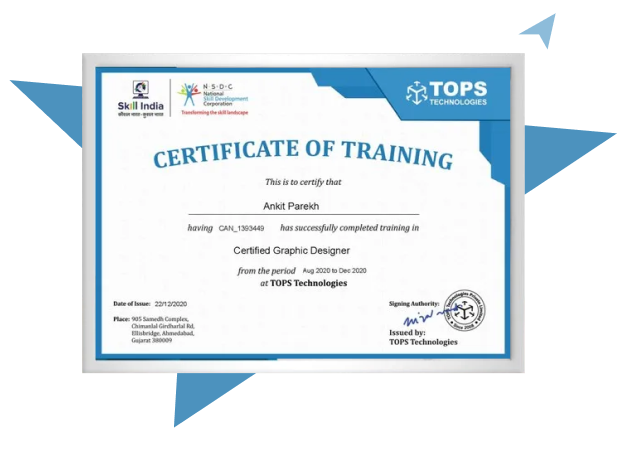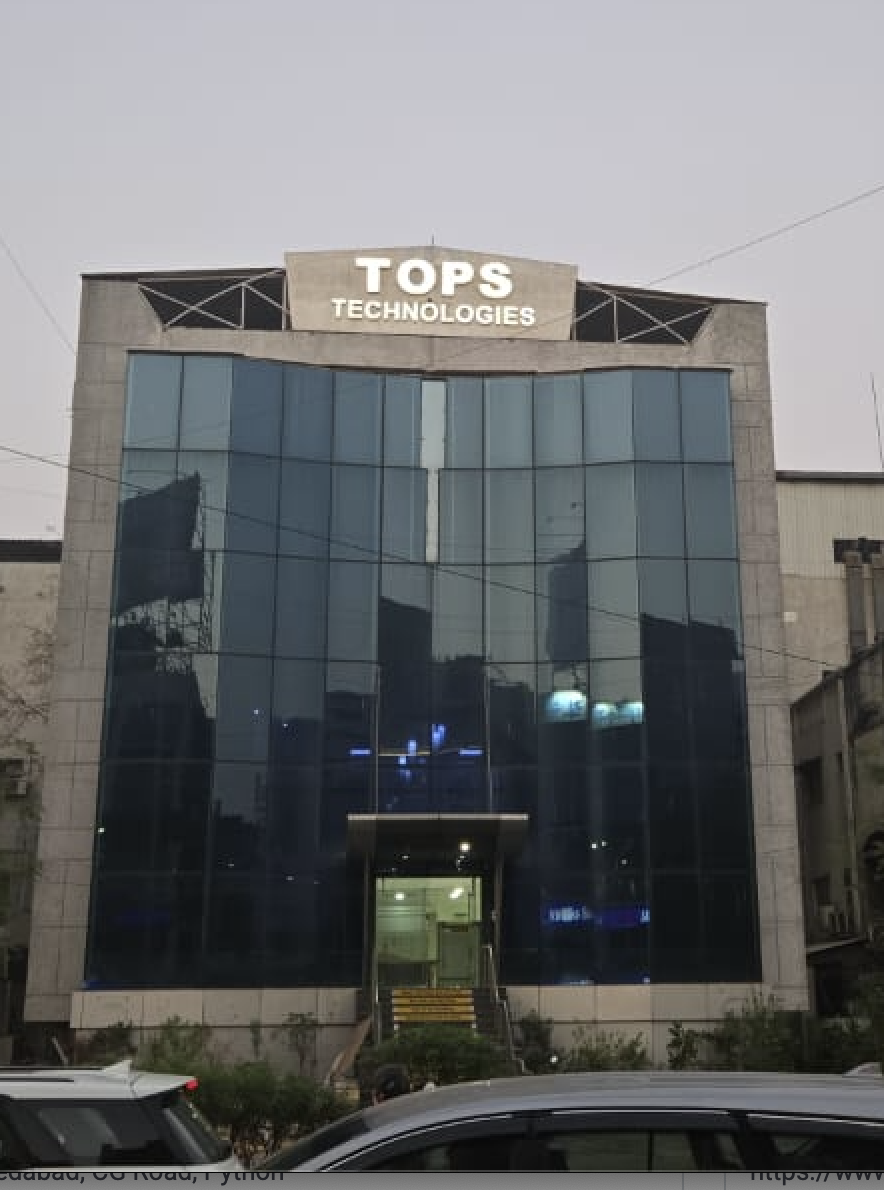Our Facts and Figures
1 Lac+
Student Placed
3000+
Companies TieUp
19+
Offices in India
50+
Industry Courses
Get 100% Job Assistance by enrolling in Certified React Training Course
Key Highlights
Limited Students Batch
Personalised Attention
Highly Qualified Teachers
Flexible Batch Timings
Interactive Learning
Live Projects
Career Support
Job Oriented Training
ReactJS Course Highlights
Personalized React Training Courses in Rajkot with Experts
Expert guidance at TOPS Technologies avails you to gain massive experience in building components with Reactjs. This makes it a full of – building large scale high-performance applications with smaller and reusable stateful components. With high competition amongst engineering students in Rajkot, the need for a specialized skill is an all-time high.
Complete ReactJS Training in Rajkot for Students & Pros
Picking up React skills is bound to widen your scope of getting the desired job. Reactjs course teaches you about the declarative, efficient, and flexible javascript framework it facilitates which in turn is useful for building interactive applications that can run on multiple platforms.
It is best to know more about the course and put your career on the right path. It is highly recommended to visit TOPS Technologies Rajkot training center and ask questions to take a constructive decision. For any inquiries, email us at inquiry@tops-int.com.
40%
Average Salary Hike
4.5 Lacs
Highest Salary
3000+
Hiring Partners
Join Our Free Upcoming Webinar
Fastest Way to Learn Data Science and Actually Get a JOB
21 Dec 2025, 11:00 AM
Trainer
Dhrumil Joshi
(Sr. Technical Trainer)
Python Full Stack Development
21 Dec 2025, 12:30 PM
Trainer
Anjali Patel
(Sr. Technical Trainer)
Motion Graphics and Animation in Design
21 Dec 2025, 02:00 PM
Trainer
Saurabh Verma
(Sr. Technical Trainer)
Learn the Website Hacks and Provide Better Security
21 Dec 2025, 04:00 PM
Trainer
Faruk Pathan
(Sr. Technical Trainer)
Full-Stack Web Development with PHP and Laravel
20 Dec 2025, 11:00 AM
Trainer
Brijesh Pandey
(Sr. Technical Trainer)
Android UI Design with Kotlin
20 Dec 2025, 12:30 PM
Trainer
Prakruti Vyas
(Sr. Technical Trainer)
Digital Marketing with AI
20 Dec 2025, 02:00 PM
Trainer
Sanket Chauhan
(Sr. Technical Trainer)
Automated vs. Manual Testing: Choosing the Right Approach
20 Dec 2025, 04:00 PM
Trainer
Rahul Sanghavi CG
(Sr. Technical Trainer)
ReactJS Course Curriculum
Download Curriculum- Course Overview
- Platforms, Frameworks & Tools
- Hybrid frameworks versus Native
- HTML5
- CSS3
- JS brush up
- ES6 Javascript Basics
- Tools Install
- React Native Hello World
- React Intro
- Getting started in React
- JSX
- Components
- Component Composition
- Props
- Prop Types
- Event Handlers
- State
- React Web App
- Creating the first App
- Understanding the App
- Styling the App
- Inspecting Debugging styles
- Built-in components
- Working with Images
- List Views
- Text Input
- Creating Views (Scenes)
- Storing data – Realm for React Native
- Integrating with Map APIs
- Creating native React components
- Routing
- Employee Directory App
- Integrating data using API
- API
- Wiring up Redux
- Asynchronous Network requests
- Dynamic properties
- Dynamic styles
- React Navigation Library
- Redux Basics
- Redux Principles
- Implementing Redux
- React-Redux
- Middleware
- Counter App Demo
Our TOPS Training Centers in India
Course Key Features
- Learn to Build Enterprise Level React Applications
- Master the Latest Ecosystem of React Developer
Skills Covered
- React
- Single Page Application
- Components
- JSX
- Events
- Iterations and Conditions
- Styling
- Dialog And Modals
- Fragments and Portals
- Class Based Components
- HTTP Module
- Custom Hook And Forms
- Redux
- Authentication
Job Roles
- Reactjs Developer
- Front End Developer
- UI Developer
Get Training Certificate by Government
Recognized NSDC/Skill India

- National Skill Development Corporation
- Supported by the vision of PM Shri Narendra Modi
- Certification by NSDC SkillIndia
- Valid for all Jobs and College Training
- International Recognition

FAQ
The course duration typically ranges from 6 to 8 weeks, depending on your learning pace and the batch type (regular, fast-track, or weekend).
Conditional rendering in React is the process of displaying different elements or components based on certain conditions. It allows developers to control what is shown to the user based on dynamic factors such as user actions, state values, or props. React uses standard JavaScript conditional operators like if, ternary (? :), and logical AND (&&) to decide what content to render. This makes the UI responsive and adaptive to user interactions, like showing a login form when the user is not authenticated and a dashboard when they are.
Event handling in React is done using a syntax similar to JavaScript but with slight differences. React uses camelCase for event names (e.g., onClick, onChange) instead of lowercase like in HTML. Event handlers are passed as functions, either inline or through a reference to another function. React also provides a synthetic event system, which wraps native events and provides consistent behavior across all browsers. Handling events in React allows components to respond to user interactions like clicks, form submissions, and input changes.
Controlled components are form elements in React where the value is controlled by React state. The input's value is bound to a state variable, and any change in the input is handled through an onChange event that updates the state. This approach gives developers complete control over form data, allowing validation, conditional rendering, and logic to be easily applied. Controlled components are considered best practice in React forms as they ensure a single source of truth for input values.
Uncontrolled components are form elements that manage their own state internally, like traditional HTML form elements. Instead of binding the input value to React state, developers use refs to access the input’s value directly from the DOM when needed (e.g., on form submission). Uncontrolled components are simpler to implement for basic forms, but they offer less control over data and are harder to validate or manipulate dynamically compared to controlled components.
Keys are unique identifiers assigned to elements in a list to help React efficiently manage and update the UI during re-rendering. When rendering a list of items using .map(), assigning a key to each element allows React to track changes such as additions, deletions, or reordering. Without keys, React would re-render all elements, which is inefficient. Using keys improves performance and ensures a smooth user experience, especially in dynamic lists.
React Fragment is a feature that lets you group multiple elements without adding extra nodes to the DOM. It helps maintain clean and semantic HTML structure by avoiding unnecessary <div> wrappers. Fragments can be written using <React.Fragment> or the shorthand syntax <> </>. This is particularly useful when a component needs to return multiple sibling elements without violating the rule that a component must return a single enclosing element.
Prop drilling is the process of passing data through multiple levels of nested components via props, even if intermediate components do not need that data. This can make the code harder to read, maintain, and debug, especially in large applications. Prop drilling is often a sign that state management or context solutions, like the React Context API or state management libraries (Redux, Zustand), might be more appropriate.
The Context API is a built-in feature in React that allows you to share state or data across the entire component tree without having to manually pass props at every level. It consists of a Provider that supplies the data and a Consumer or the useContext hook that accesses it. The Context API is ideal for managing global data like themes, authentication, or user preferences in a scalable and maintainable way.
- State is a local, mutable data structure that belongs to a component. It is managed within the component and can change over time, triggering re-renders.
- Props (short for properties) are immutable and passed from a parent component to a child. They are used to pass data or functions into a component but cannot be modified by the child.
Together, state and props control how components behave and what they display, forming the backbone of React’s data-driven architecture.
Interview Questions
Reconciliation is the internal process React uses to efficiently update the user interface. When a component’s state or props change, React creates a new Virtual DOM and compares it with the previous one using a diffing algorithm. Based on this comparison, React calculates the minimum number of changes required and updates the real DOM accordingly. This process ensures high performance and minimizes unnecessary DOM manipulations.
Fragments are special React components that let you group multiple child elements without adding extra nodes to the DOM. Instead of wrapping elements in a <div>, you can use <React.Fragment> or the shorthand <>. This helps in maintaining cleaner HTML structure and avoids potential issues with unnecessary nesting in layouts and styling.
React.StrictMode is a development-only tool used to identify unsafe or deprecated lifecycle methods, side effects, or legacy API usage in React components. It doesn’t render any visible UI and doesn’t affect the production build. By wrapping parts of your app in <StrictMode>, React helps developers spot potential bugs early and adopt best practices.
Higher-Order Components are functions that take a component and return a new component with enhanced behavior. They are commonly used for code reuse, manipulating props, managing authentication, or injecting logic. For example, an HOC could add logging, theming, or data-fetching functionality without modifying the original component.
- React.memo is a higher-order component used to prevent re-rendering of a component if its props haven’t changed. It’s useful for optimizing functional components.
- useMemo, on the other hand, is a hook used to memoize the result of a computation. It recalculates the value only when dependencies change. While both optimize performance, React.memo targets components, whereas useMemo targets calculated values.
React handles errors through error boundaries, which are components that catch JavaScript errors in their child components during rendering, lifecycle methods, and constructors. They use the componentDidCatch() lifecycle method and getDerivedStateFromError() to display fallback UI, preventing the entire app from crashing due to a single component failure.
defaultProps allows you to define default values for props that are not provided by the parent component. This ensures that the component still behaves correctly even when some props are missing. It simplifies component configuration and avoids the need for null checks or undefined values within the component.
A PureComponent in React is a type of class component that automatically implements a shallow comparison in shouldComponentUpdate(). It prevents the component from re-rendering unless there are actual changes in props or state. This helps in performance optimization by avoiding unnecessary re-renders, especially in large applications.
React.lazy() is used for dynamic importing of components. It enables code-splitting, which means components are loaded only when needed. This reduces the initial bundle size and improves performance, especially in large-scale applications. It must be used with React.Suspense to display a fallback UI while the component is being loaded.
Code-splitting in React is implemented using React.lazy() and React.Suspense. It allows developers to load parts of the application on demand rather than bundling everything together. This technique helps improve performance and user experience by reducing load times and enabling smoother navigation in the app.
Latest Blogs
How to Make the Switch from Non-IT to IT?
Are you curious about the journey from non-IT to IT? Surprisingly, the door is wider open than you m...
View full BlogWhat Is React? – Unveiling the Secrets of Interac...
React is a popular option among developers because of its many benefits. The following are some stro...
View full BlogReactJS vs AngularJS: A Guide to JavaScript Framew...
Here we will talk about the two frameworks and one of the frequently neglected topics in such course...
View full Blog








